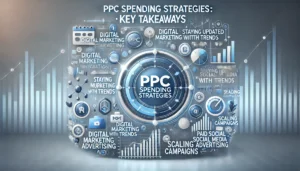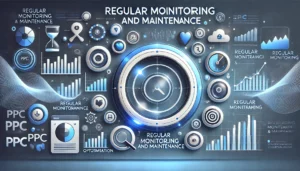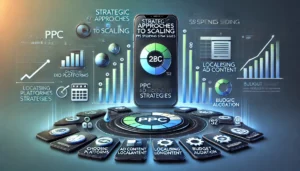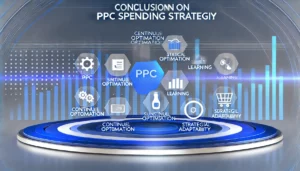PPC Spending Strategies: Revolutionising Your Approach: A New Take on Budget Allocation

PPC Spending Strategies: In today’s fast-paced digital world, Pay-Per-Click (PPC) advertising is a crucial tool for businesses aiming to boost their online presence. However, it’s not just about spending money on ads; it’s about spending it wisely. This article will guide you through innovative strategies to optimise your PPC campaigns, ensuring you get the most out of every penny spent.
PPC Spending Strategies: Key Takeaways
- Integrating PPC with your overall digital marketing efforts can lead to better results and a stronger online presence.
- Staying updated with digital trends and continuously optimising your PPC strategies is essential for sustained growth.
- Understanding the unique benefits of each PPC platform can help you make informed decisions and maximise your advertising budget.
- Blending paid social media advertising with your PPC strategy can boost brand awareness and engagement.
- Scaling PPC campaigns effectively requires a strategic approach and a thorough understanding of new target markets.
Understanding the Core Principles of PPC Spending Strategies
To truly excel in PPC advertising, we must first grasp the core principles that drive successful campaigns. Setting clear marketing goals is the foundation of any effective PPC strategy. Without well-defined objectives, it’s challenging to measure success or make informed adjustments.
Conducting effective keyword research is another crucial step. By identifying the right keywords, we can target our audience more precisely and maximise our advertising spend. This involves understanding what potential customers are searching for and aligning our ads accordingly.
Harnessing the power of smart bidding can significantly enhance our PPC efforts. Smart bidding uses machine learning to optimise bids for each auction, helping us achieve better results with less manual effort. This approach allows us to focus on strategic decisions while the system handles the complexities of bid management.
By understanding the unique advantages of each PPC platform and aligning them with our marketing strategy, we can make informed decisions that maximise our advertising spend and improve our campaign’s overall success rate.
Integrating PPC with Your Overall Digital Marketing Strategy
By strategically integrating PPC advertising with other aspects of your digital marketing strategy, we can create a comprehensive approach that leverages the strengths of each channel. This leads to better results and a stronger online presence.
Blending Paid Social Media Advertising
Effective integration of pay-per-click (PPC) advertising into your broader digital marketing strategy can amplify your online presence and create a cohesive user experience. PPC can complement and enhance other digital marketing efforts, such as SEO, social media, and content marketing.
Leveraging Display Ads for Enhanced Visibility
As the digital world evolves, so too should our strategies. Staying ahead of the curve in PPC can dramatically enhance our marketing effectiveness and contribute to sustained business growth. Remember, the key to successful PPC is a combination of strategic planning, continuous optimisation, and adaptive learning.
Maximising Ad Placements on Social Platforms
By understanding the unique advantages of each PPC platform and aligning them with our marketing strategy, we can make informed decisions that maximise our advertising spend and improve our campaign’s overall success rate.
Setting Up and Managing a Successful PPC Campaign
Setting up and managing a successful PPC campaign requires careful planning, ongoing monitoring, and continuous optimisation. This section will guide you through the essential steps to establish and maintain an effective PPC campaign.
The Role of Continuous Optimisation in PPC Success (PPC Spending Strategies)
Continuous optimisation is crucial for the success of any PPC campaign. We must regularly review our campaigns and adjust our keywords, ad copy, and bidding strategies based on performance data. This ongoing process helps us stay ahead of the curve and ensures our marketing efforts are effective.
Regular Monitoring and Maintenance
Regular maintenance is often overlooked, especially by PPC newbies. However, the landscape is constantly shifting, and we need to keep up. By paying attention to key components and continuously refining our PPC campaigns, we can increase our chances of success and achieve our marketing goals. Remember, PPC is not a one-time effort but an ongoing process that requires constant monitoring and optimisation.
Adapting to Market Changes
As the digital world evolves, so should our strategies. Staying ahead of market changes can dramatically enhance our marketing effectiveness and contribute to sustained business growth. We should experiment with new strategies, ad formats, and targeting methods to find the most effective combinations. This adaptive learning is key to staying relevant in a fast-paced environment.
Utilising Automation and AI
Automation and AI are becoming increasingly important in PPC management. These tools can help us optimise our campaigns more efficiently by automating routine tasks and providing insights based on data analysis. For instance, smart bidding strategies can adjust bids in real-time to maximise ROI. Embracing these technologies can give us a competitive edge and improve our overall campaign performance.
Leveraging Ad Extensions and Formats for Maximum Impact
Beyond text-based search ads, many other types such as display ads or shopping ads can be used depending upon the business needs. Additionally, using ad extensions – additional pieces of information about the business – enhances visibility while improving clickthrough rates too.
Scaling Your PPC Campaigns Across New Markets
Expanding into new markets can be a rewarding endeavour, but it requires careful planning and execution. By adapting your PPC campaigns to local preferences and setting realistic goals and budgets, you can increase your chances of success and establish a strong presence in new markets.
Understanding Target Markets
Scaling PPC campaigns across new markets can be a challenging task. However, with a strategic approach and thorough understanding of the target markets, you can effectively expand your reach and drive significant results. By implementing the strategies outlined in this article, you will be well-equipped to scale your PPC campaigns and achieve success in new markets.
Strategic Approaches to Scaling (PPC Spending Strategies)
With a market entry strategy in place, it’s time to implement your PPC campaign in the new markets. Here are a couple of key considerations:
- Choosing the Right Platforms: Different markets may favour different advertising platforms. Research and select the platforms that are most popular in your target market.
- Localising Ad Content: Tailor your ad copy and visuals to resonate with the local audience. This includes language, cultural references, and even local trends.
- Budget Allocation: Allocate your budget wisely, focusing on high-potential areas first before expanding further.
Measuring Success and ROI
In conclusion, identifying potential new markets for your PPC campaigns involves analysing market trends and evaluating market competition. By conducting thorough research and understanding the dynamics of different regions, you can strategically expand your campaigns into markets that offer growth opportunities. Furthermore, assessing the competition helps you identify gaps in the market and refine your advertising strategies to stand out from your competitors.
Scaling PPC campaigns across new markets can be a challenging task. However, with a strategic approach and thorough understanding of the target markets, you can effectively expand your reach and drive significant results.
Staying Ahead with Future Trends in PPC Marketing
As the digital world evolves, so too should our strategies. Staying ahead of the curve in PPC can dramatically enhance our marketing effectiveness and contribute to sustained business growth. Remember, the key to successful PPC is a combination of strategic planning, continuous optimisation, and adaptive learning.
The Benefits of Integrating Social Media into Your PPC Strategy
Integrating social media into our PPC strategy can bring numerous benefits. Many companies frequently overlook the advantages of incorporating paid social media advertising into their general PPC approach. But it’s an avenue that offers unique opportunities to reach your target audience and enhance brand visibility.
PPC Spending Strategies: Boosting Brand Awareness
Blending paid social media advertising with our PPC strategy can significantly boost brand awareness. Platforms like Facebook Ads or LinkedIn allow us to target users based on specific interests, thereby increasing our reach. Don’t overlook the power of this blend.
Engagement Through Targeted Ads
PPC ads on platforms like Facebook, Instagram, and LinkedIn can significantly enhance our social media strategies by increasing reach and engagement. We can use PPC to promote social media posts that are performing well organically to extend their reach or to target new audiences who may not yet follow our brand but have shown interest in similar products or services.
Cross-Channel Synergy
By strategically integrating PPC advertising with other aspects of our digital marketing strategy, we can create a comprehensive approach that leverages the strengths of each channel. This leads to better results and a stronger online presence.
Paid social media ads have seen a steady rise in popularity as an effective way of connecting with target audiences on their preferred platforms. Integrating Facebook Ads or Bing Ads with our broader PPC strategy can boost brand awareness and increase click-through rates (CTR).
Evolving Your PPC Strategies for the Digital Future
The digital landscape is always changing, and to stay competitive, our PPC strategies must change too. We need to be flexible and come up with new ideas to keep our PPC campaigns up-to-date with the latest trends and technologies.
Staying Adaptive and Innovative
As the digital world evolves, so should our strategies. Staying ahead in PPC can greatly improve our marketing and help our business grow. The key to successful PPC is a mix of planning, constant improvement, and learning new things.
Proactive Campaign Refinement
To keep our PPC campaigns effective, we must regularly review and update them. This means looking at what works and what doesn’t, and making changes as needed. By doing this, we can make sure our campaigns are always performing at their best.
Embracing New Technologies
New technologies are always coming out, and we need to use them to our advantage. For example, voice search is becoming more popular, and we should think about how it can fit into our PPC strategies. By staying on top of new tech, we can keep our campaigns fresh and effective.
Ecommerce PPC is a great example of how staying updated with new trends can lead to better results. By using the latest tools and techniques, we can make sure our ads reach the right people and get the best results.
Maintaining a Competitive Ad Rank (PPC Spending Strategies)
To keep our ads at the top, we need to understand the factors that influence our ad rank. Ad rank is determined by several elements, including our bid amount, the quality of our ads, and the relevance of our ad text. It’s essential to monitor these factors closely for optimal performance. But don’t forget, tweaking them regularly can help you get better results.
Understanding Ad Rank Factors
Ad rank is not just about how much we are willing to pay per click. It also involves the quality score, which is a measure of how relevant our ad is to the user. This score is influenced by the click-through rate, the relevance of each keyword to its ad group, and the quality of the landing page. Regularly conducting a Google ads audit can help us identify areas for improvement.
Strategies to Improve Ad Rank
To improve our ad rank, we should focus on enhancing our quality score. This can be achieved by creating more relevant ads, improving our landing pages, and ensuring our keywords are closely related to our ads. Additionally, using ad extensions can provide more information to users and improve our click-through rates. Partnering with experienced Google ads agencies can also offer valuable insights and strategies.
Monitoring Competitor Activity
Keeping an eye on what our competitors are doing can provide us with valuable insights. By understanding their strategies, we can adjust our own to stay ahead. Tools like competitive analysis reports can help us see where we stand in comparison to others in our industry. Regularly reviewing these reports ensures we remain competitive and can adapt to any changes in the market.
Regular monitoring and adjustments are key to maintaining a competitive ad rank. By staying proactive, we can ensure our ads continue to perform well and attract the right audience.
PPC Spending Strategies: Direct Audience Booking Tactics for Targeted Campaigns
Understanding the challenge of reaching your target audience can often feel like navigating a maze. Many marketers struggle with segmenting their audience effectively. However, by identifying your target audience, we can create more focused and successful campaigns.
Identifying Your Target Audience
Knowing who we want to reach is the first step. We need to consider factors like age, gender, location, and interests. This helps us tailor our messages to the right people. Using in-market audiences, which are groups actively looking to buy specific products or services, offers an additional strategy. By targeting these audiences, we reach people already in the mindset to make a purchase or sign a contract, significantly increasing the likelihood of conversion.
Effective Audience Segmentation
Once we know our audience, we can segment them into smaller groups. This allows us to create more personalised ads. For example, we can use geographic targeting to show ads to users based on their location. This is especially useful for local businesses. Tailoring ads based on local events, weather, or cultural preferences can greatly enhance relevance and engagement.
Personalised Ad Messaging
Creating personalised messages for each segment is crucial. We can use demographic targeting to customise our messaging to resonate with specific segments of our audience. Platforms like Google Ads and Facebook Ads provide options to target audiences based on age, gender, marital status, and more. This improves the chances of conversion.
By setting our campaigns to ‘Presence: People in or regularly in your targeted locations,’ we connect with audiences who are physically present or frequently visit our chosen areas. Otherwise, our ads will appear to people outside our intended geographic area, who are less likely to be interested in our product or service.
Want to reach your audience directly and make your campaigns more effective? Our expert team can help you target the right people and get the best results. Get your free pay per click audit to learn more and get started today!
Conclusion on PPC Spending Strategies
In conclusion, revolutionising your PPC spending strategies is not just about keeping up with trends but about creating a well-rounded approach that integrates seamlessly with your overall digital marketing efforts. By understanding the unique strengths of each PPC platform and continuously optimising your campaigns, you can achieve better results and a more robust online presence. Remember, the key to success lies in strategic planning, ongoing learning, and adaptability. As the digital landscape evolves, so should your strategies. Stay ahead of the curve, and your business will thrive in the ever-changing world of digital marketing.
Frequently Asked Questions
What are PPC spending strategies?
PPC spending strategies are plans that help you manage your pay-per-click advertising budget effectively. They involve setting clear goals, choosing the right keywords, and continuously optimising your campaigns.
Why is it important to set clear marketing goals?
Clear marketing goals help you focus your PPC efforts and measure success. They guide your strategy and ensure that your campaigns are aligned with your business objectives.
How do I conduct effective keyword research?
Effective keyword research involves finding and analysing search terms that people use to find products or services like yours. Use tools like Google Keyword Planner to discover relevant keywords and assess their competition and search volume.
What is smart bidding in PPC?
Smart bidding is an automated bidding system that uses machine learning to optimise your bids. It helps you get the best results from your PPC campaigns by adjusting bids based on real-time data.
How can I integrate PPC with my overall digital marketing strategy?
You can integrate PPC with your digital marketing strategy by blending it with paid social media ads, using display ads for visibility, and making the most of ad placements on social platforms. This creates a cohesive approach that leverages each channel’s strengths.
What are ad extensions and how do they help?
Ad extensions are additional pieces of information that you can add to your PPC ads, such as phone numbers, links to specific pages, or customer reviews. They make your ads more informative and can improve click-through rates.
Why is continuous optimisation important in PPC?
Continuous optimisation is crucial because the digital landscape is always changing. Regularly updating and refining your PPC campaigns helps you stay competitive and achieve better results.
What are some future trends in PPC marketing?
Future trends in PPC marketing include voice search optimisation, the rise of visual and video ads, and the use of predictive analytics. Staying ahead of these trends can help you maintain a competitive edge.
Author
Search Blog
Free PPC Audit
Subscribe to our Newsletter
The Voices of Our Success: Your Words, Our Pride
Don't just take our word for it. With over 100+ five-star reviews, we let our work-and our satisfied clients-speak for us.
"We have been working with PPC Geeks for around 6 months and have found Mark and the team to be very impressive. Having worked with a few companies in this and similar sectors, I rate PPC Geeks as the strongest I have come across. They have taken time to understand our business, our market and competitors and supported us to devise a strategy to generate business. I value the expertise Mark and his team provide and trust them to make the best recommendations for the long-term."
~ Just Go, Alasdair Anderson




